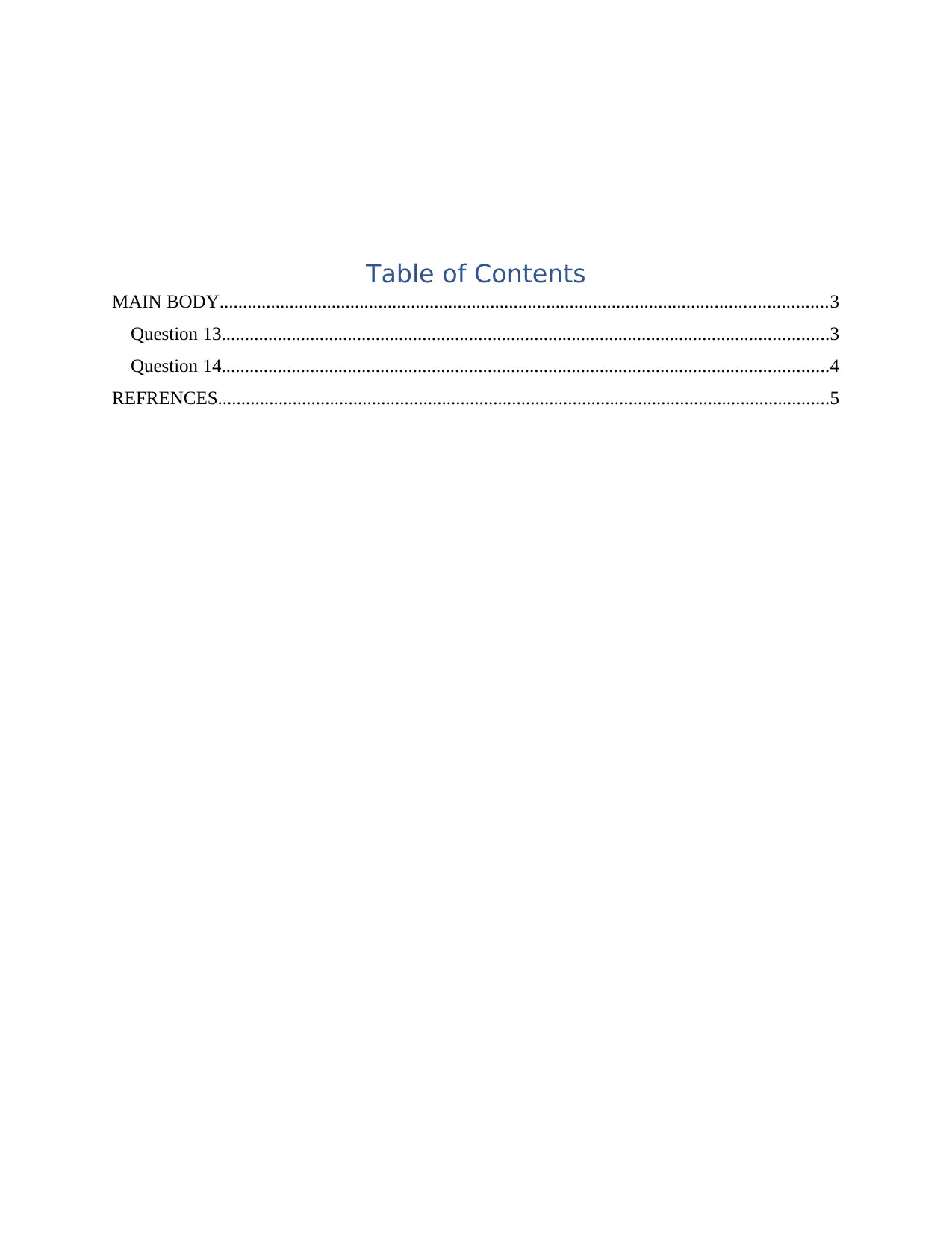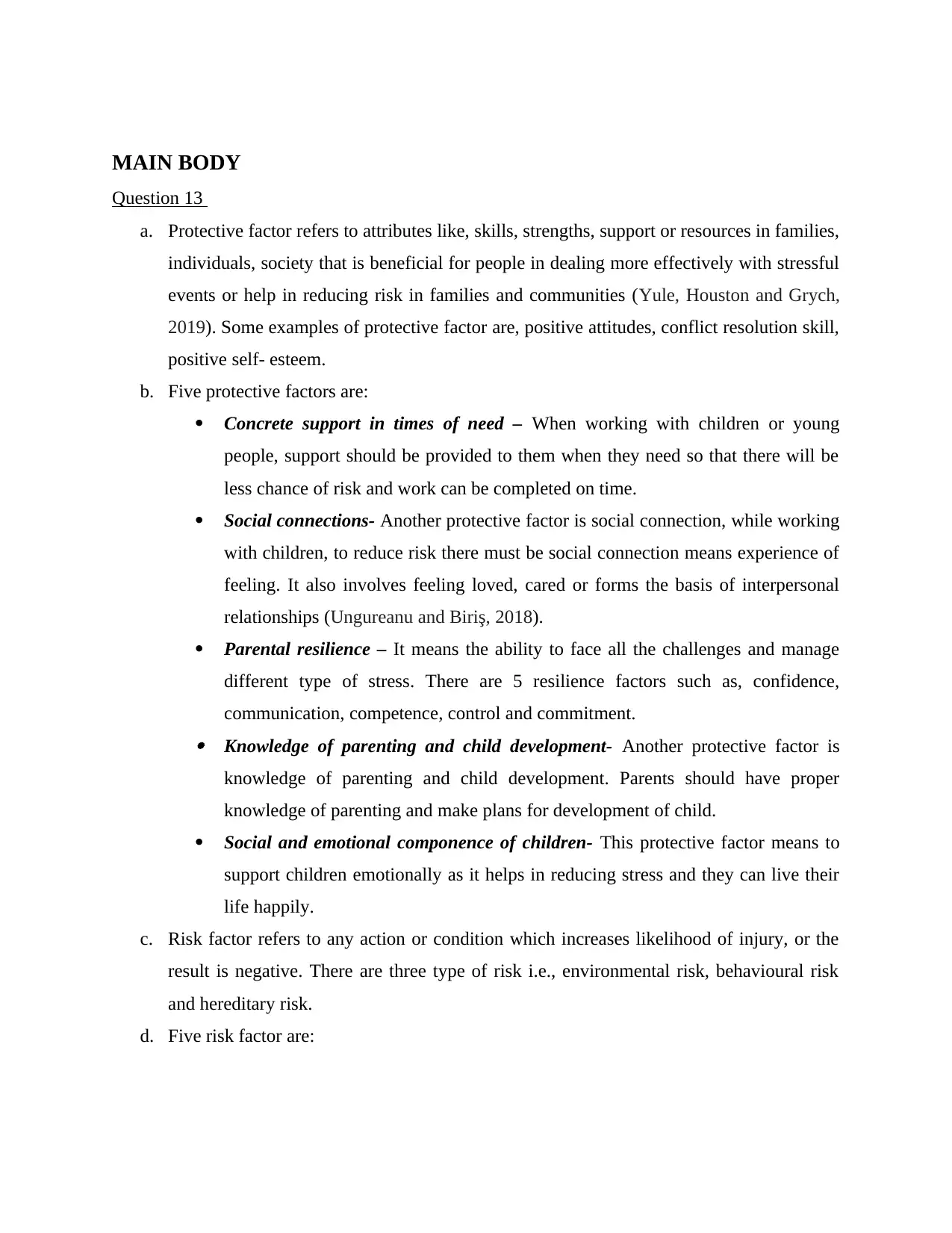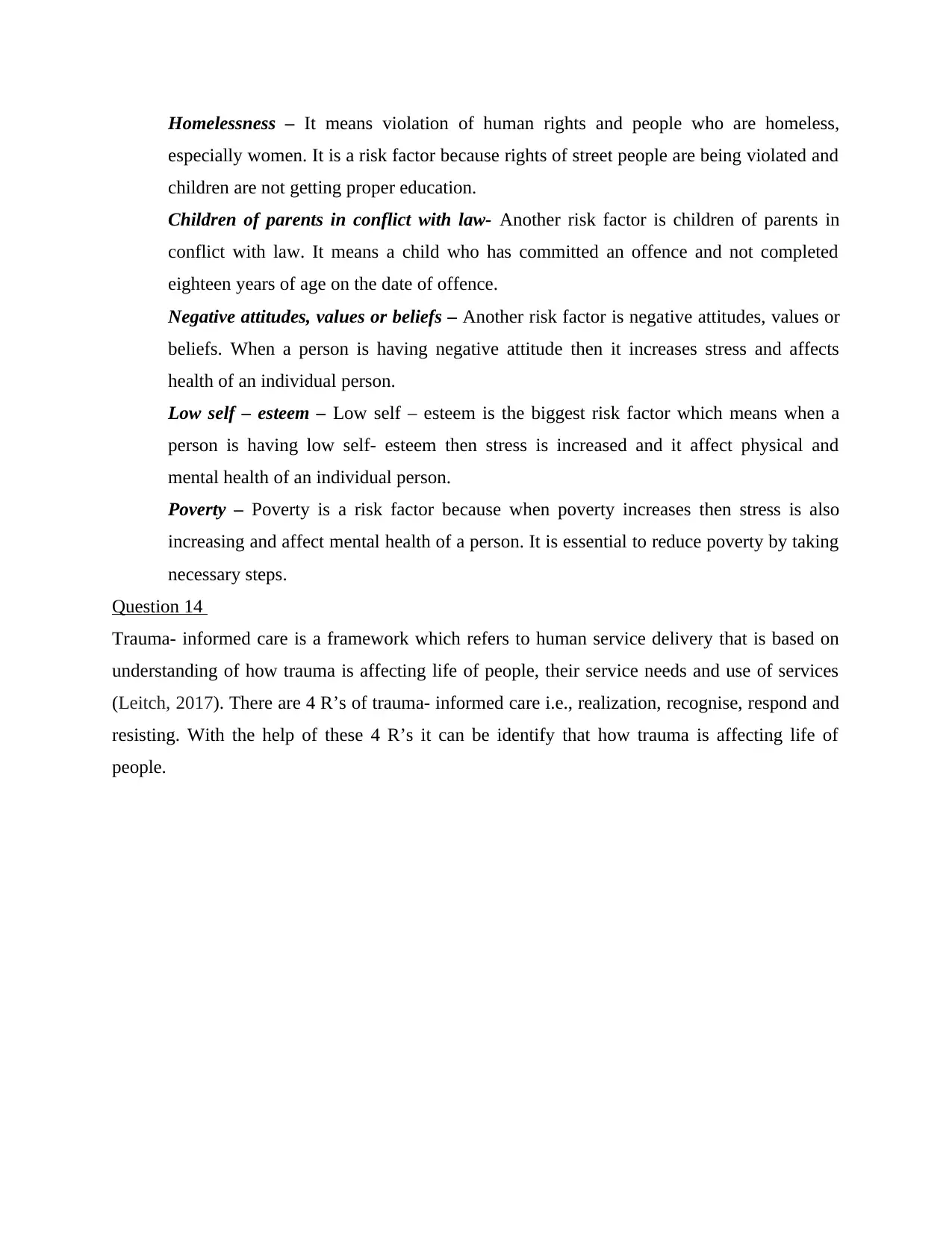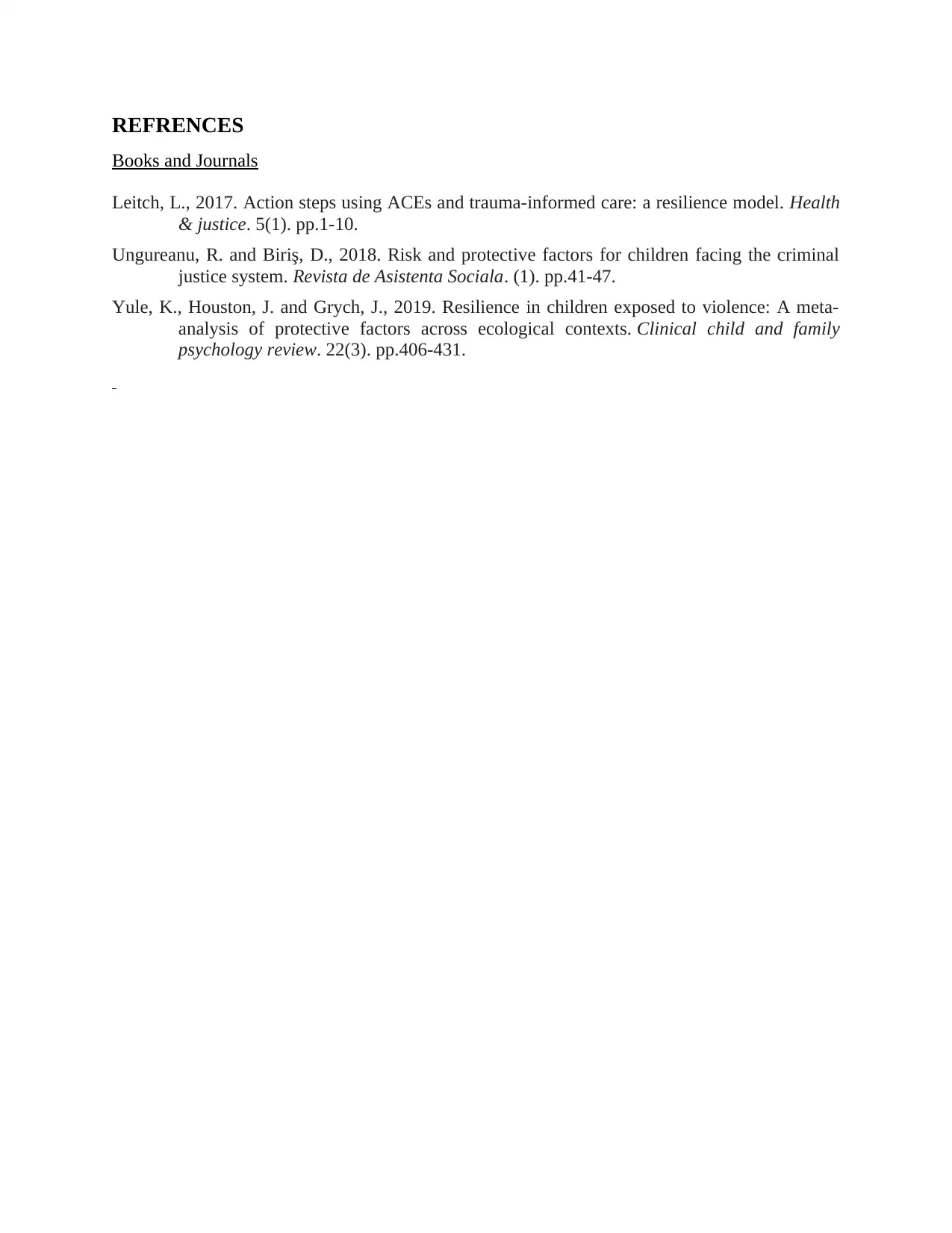Analysis of Risk, Protective Factors & Trauma-Informed Care Approach
VerifiedAdded on 2023/06/18
|5
|721
|389
Homework Assignment
AI Summary
This assignment provides an overview of protective and risk factors and trauma-informed care. It defines protective factors as attributes that help individuals cope with stress and reduce risk, highlighting concrete support, social connections, parental resilience, knowledge of parenting, and social-emotional competence. Risk factors are defined as conditions increasing the likelihood of negative outcomes, including homelessness, children of parents in conflict with the law, negative attitudes, low self-esteem, and poverty. The assignment also discusses trauma-informed care as a framework for human service delivery, emphasizing the 4 R’s: realization, recognize, respond, and resisting. Desklib offers similar solved assignments and study resources for students.

Question
Paraphrase This Document
Need a fresh take? Get an instant paraphrase of this document with our AI Paraphraser

Table of Contents
MAIN BODY..................................................................................................................................3
Question 13..................................................................................................................................3
Question 14..................................................................................................................................4
REFRENCES...................................................................................................................................5
MAIN BODY..................................................................................................................................3
Question 13..................................................................................................................................3
Question 14..................................................................................................................................4
REFRENCES...................................................................................................................................5

MAIN BODY
Question 13
a. Protective factor refers to attributes like, skills, strengths, support or resources in families,
individuals, society that is beneficial for people in dealing more effectively with stressful
events or help in reducing risk in families and communities (Yule, Houston and Grych,
2019). Some examples of protective factor are, positive attitudes, conflict resolution skill,
positive self- esteem.
b. Five protective factors are:
Concrete support in times of need – When working with children or young
people, support should be provided to them when they need so that there will be
less chance of risk and work can be completed on time.
Social connections- Another protective factor is social connection, while working
with children, to reduce risk there must be social connection means experience of
feeling. It also involves feeling loved, cared or forms the basis of interpersonal
relationships (Ungureanu and Biriş, 2018).
Parental resilience – It means the ability to face all the challenges and manage
different type of stress. There are 5 resilience factors such as, confidence,
communication, competence, control and commitment.
Knowledge of parenting and child development- Another protective factor is
knowledge of parenting and child development. Parents should have proper
knowledge of parenting and make plans for development of child.
Social and emotional componence of children- This protective factor means to
support children emotionally as it helps in reducing stress and they can live their
life happily.
c. Risk factor refers to any action or condition which increases likelihood of injury, or the
result is negative. There are three type of risk i.e., environmental risk, behavioural risk
and hereditary risk.
d. Five risk factor are:
Question 13
a. Protective factor refers to attributes like, skills, strengths, support or resources in families,
individuals, society that is beneficial for people in dealing more effectively with stressful
events or help in reducing risk in families and communities (Yule, Houston and Grych,
2019). Some examples of protective factor are, positive attitudes, conflict resolution skill,
positive self- esteem.
b. Five protective factors are:
Concrete support in times of need – When working with children or young
people, support should be provided to them when they need so that there will be
less chance of risk and work can be completed on time.
Social connections- Another protective factor is social connection, while working
with children, to reduce risk there must be social connection means experience of
feeling. It also involves feeling loved, cared or forms the basis of interpersonal
relationships (Ungureanu and Biriş, 2018).
Parental resilience – It means the ability to face all the challenges and manage
different type of stress. There are 5 resilience factors such as, confidence,
communication, competence, control and commitment.
Knowledge of parenting and child development- Another protective factor is
knowledge of parenting and child development. Parents should have proper
knowledge of parenting and make plans for development of child.
Social and emotional componence of children- This protective factor means to
support children emotionally as it helps in reducing stress and they can live their
life happily.
c. Risk factor refers to any action or condition which increases likelihood of injury, or the
result is negative. There are three type of risk i.e., environmental risk, behavioural risk
and hereditary risk.
d. Five risk factor are:
⊘ This is a preview!⊘
Do you want full access?
Subscribe today to unlock all pages.

Trusted by 1+ million students worldwide

Homelessness – It means violation of human rights and people who are homeless,
especially women. It is a risk factor because rights of street people are being violated and
children are not getting proper education.
Children of parents in conflict with law- Another risk factor is children of parents in
conflict with law. It means a child who has committed an offence and not completed
eighteen years of age on the date of offence.
Negative attitudes, values or beliefs – Another risk factor is negative attitudes, values or
beliefs. When a person is having negative attitude then it increases stress and affects
health of an individual person.
Low self – esteem – Low self – esteem is the biggest risk factor which means when a
person is having low self- esteem then stress is increased and it affect physical and
mental health of an individual person.
Poverty – Poverty is a risk factor because when poverty increases then stress is also
increasing and affect mental health of a person. It is essential to reduce poverty by taking
necessary steps.
Question 14
Trauma- informed care is a framework which refers to human service delivery that is based on
understanding of how trauma is affecting life of people, their service needs and use of services
(Leitch, 2017). There are 4 R’s of trauma- informed care i.e., realization, recognise, respond and
resisting. With the help of these 4 R’s it can be identify that how trauma is affecting life of
people.
especially women. It is a risk factor because rights of street people are being violated and
children are not getting proper education.
Children of parents in conflict with law- Another risk factor is children of parents in
conflict with law. It means a child who has committed an offence and not completed
eighteen years of age on the date of offence.
Negative attitudes, values or beliefs – Another risk factor is negative attitudes, values or
beliefs. When a person is having negative attitude then it increases stress and affects
health of an individual person.
Low self – esteem – Low self – esteem is the biggest risk factor which means when a
person is having low self- esteem then stress is increased and it affect physical and
mental health of an individual person.
Poverty – Poverty is a risk factor because when poverty increases then stress is also
increasing and affect mental health of a person. It is essential to reduce poverty by taking
necessary steps.
Question 14
Trauma- informed care is a framework which refers to human service delivery that is based on
understanding of how trauma is affecting life of people, their service needs and use of services
(Leitch, 2017). There are 4 R’s of trauma- informed care i.e., realization, recognise, respond and
resisting. With the help of these 4 R’s it can be identify that how trauma is affecting life of
people.
Paraphrase This Document
Need a fresh take? Get an instant paraphrase of this document with our AI Paraphraser

REFRENCES
Books and Journals
Leitch, L., 2017. Action steps using ACEs and trauma-informed care: a resilience model. Health
& justice. 5(1). pp.1-10.
Ungureanu, R. and Biriş, D., 2018. Risk and protective factors for children facing the criminal
justice system. Revista de Asistenta Sociala. (1). pp.41-47.
Yule, K., Houston, J. and Grych, J., 2019. Resilience in children exposed to violence: A meta-
analysis of protective factors across ecological contexts. Clinical child and family
psychology review. 22(3). pp.406-431.
Books and Journals
Leitch, L., 2017. Action steps using ACEs and trauma-informed care: a resilience model. Health
& justice. 5(1). pp.1-10.
Ungureanu, R. and Biriş, D., 2018. Risk and protective factors for children facing the criminal
justice system. Revista de Asistenta Sociala. (1). pp.41-47.
Yule, K., Houston, J. and Grych, J., 2019. Resilience in children exposed to violence: A meta-
analysis of protective factors across ecological contexts. Clinical child and family
psychology review. 22(3). pp.406-431.
1 out of 5
Related Documents
Your All-in-One AI-Powered Toolkit for Academic Success.
+13062052269
info@desklib.com
Available 24*7 on WhatsApp / Email
![[object Object]](/_next/static/media/star-bottom.7253800d.svg)
Unlock your academic potential
Copyright © 2020–2025 A2Z Services. All Rights Reserved. Developed and managed by ZUCOL.





